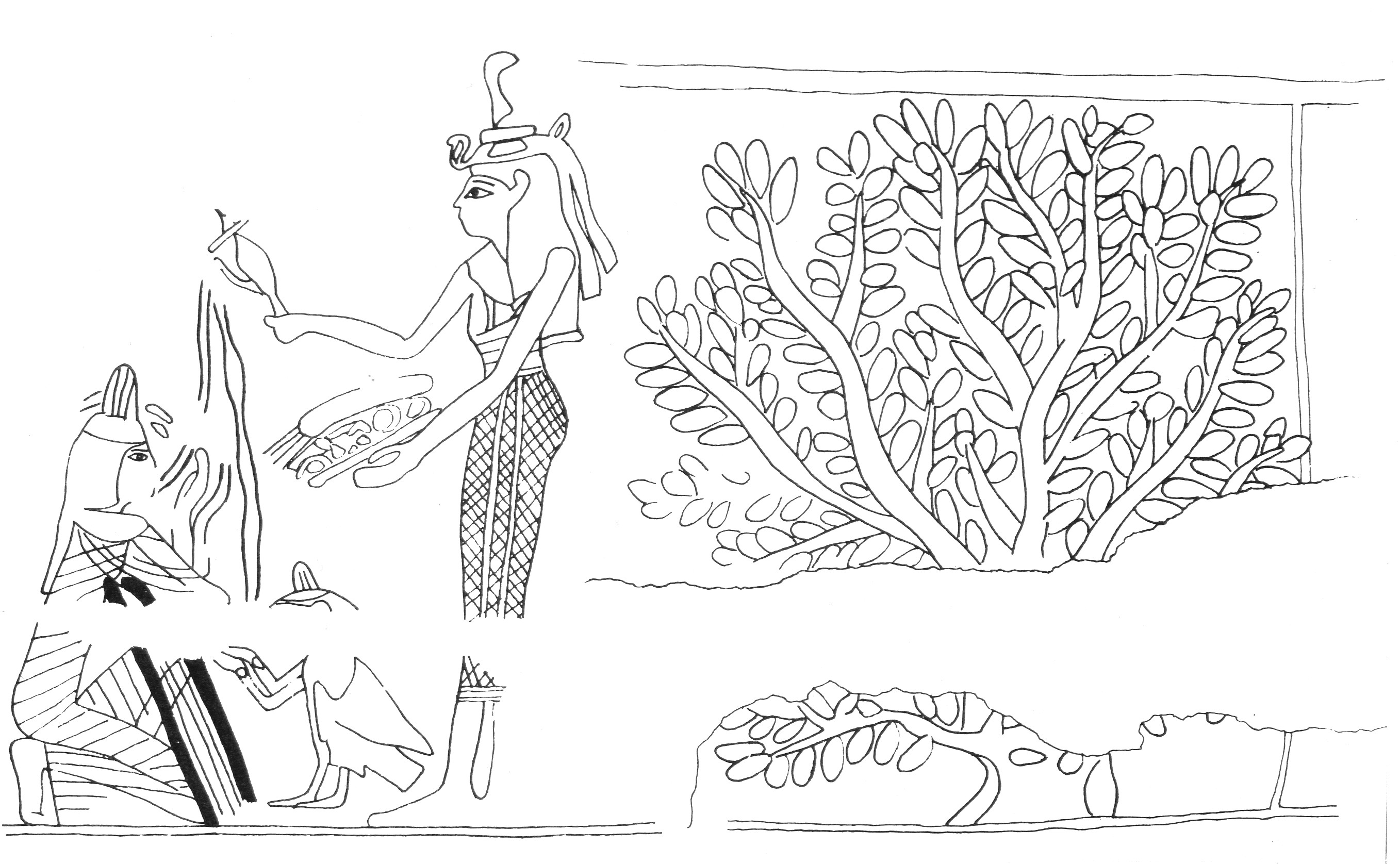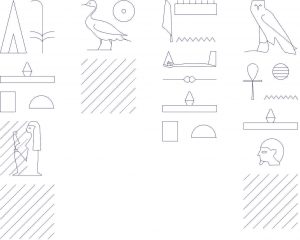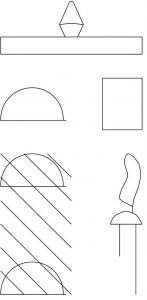W1982 Tree goddess
The tree-goddess, the musician and her ba-bird
 Here you can see from left to right: the musician kneeling, her ba-bird, a sycamore tree goddess and a sycamore tree.
Here you can see from left to right: the musician kneeling, her ba-bird, a sycamore tree goddess and a sycamore tree.
This scene shows the sycamore tree goddess, with the Ma’at feather on her head, standing in front of the tree, giving libations to the priestess who is kneeling. Her ba-bird stands between the priestess and the goddess. Such depictions of tree goddesses reviving the deceased are common from the 18th Dynasty (1500 BC onwards) and the Centre has another depiction of such a scene on a piece of cartonnage (EC490).
The scene of the sycamore goddess providing nourishment to the deceased is commonly placed at the foot end of 21st Dynasty coffins often in front of the Hathor in mountain motif (Billing 2002, 293), for example ÄS6265 from Wein (CAA 1994). Our coffin is thus no exception. Niwiński (2006) suggests that the scene of the sycamore tree goddess, like that of Hathor coming out of the mountain may at one level represent an actual visit to Deir el-Bahri. Sycamore trees were placed outside the Montuhotep temple at Deir el-Bahri. However, trees, of which the sycamore was for the Egyptians the archetypal example, are also placed around graves more generally (Wilkinson 1998, 63–118) and could well have been the site of offering to the deceased. Billing (2002, 293) cites a reference which give the location of the tree goddess as ‘the Field of the Necropolis’.
While the roots of the idea of the tree goddess go back to the Pyramid Texts (Billing 2002), depictions were not common until the New Kingdom, the first example being in the tomb of Thutmosis III (1479-1426 BC). They are also apparent in other New Kingdom tombs but are particularly common of coffins of the 21st Dynasty. In some cases the sycamore goddess is part of the tree, though during the Third Intermediate Period the goddess is increasingly separated from her tree (Billing 2002, 200).
The sycamore goddess, on the Swansea coffin, as on other coffins and as with other goddesses on our coffin, is shown wearing a dress patterned with lozenges. This may represent the starry sky or alternatively the feathers of the hawk. The identity of the Swansea sycamore goddess is ambiguous. Billing (2002) states that a number of mother goddesses could manifest themselves as the tree goddess, who was often deliberately left unnamed. On 21st Dynasty coffins she is usually Nut (Keel 1992, 89; Billing 2002, 303) or less commonly the goddess of the West, Hathor, Isis or Neith. Hathor was often called ‘lady of the Sycamore’. Our goddess seems to be Nut possibly combined with Ma’at.
Billing (2002, 297, 304), presumably on the evidence of the feather on the head of the goddess, sees her as the goddess of the West. The feather, however may alternatively be that of Ma’at. The text possibly supports this. The four columns of writing in front of her head are:

: Htp di nsw MA’t …
sAt Ra…..
imn di s Htp
m anxw…..
This can be translated as: ‘an offering which the king gives to Maat, the Daughter of Re [to the Chantress] of Amun [so that] she gives an offering of life.
Behind the head of the deceased are the glyphs which may or may not be a part of the whole phrase. These read:

Htp imntt
‘an offering of the west’, i.e. a funerary offering.
The item on the lap of the seated goddess glyph is probably a feather though is difficult to decipher. However, the label behind the tree reads:

Nwt wrt ms nTr (w)….
‘Nut the Great, born of the gods.’
‘Nut the Great’ appears as a title of Nut from the New Kingdom and on 21st Dynasty coffins (Leitz 2002, vol. IV, 538–539). On the opposite side of the coffin, at the foot end, a similar text is situated. The syncratic nature of Egyptian goddesses is not unusual. For example on Uppsala VM 228 (Billing 2002, 303, fig. E6; Englund 1974, fig. 7) the goddess wears a Neith sign but is called Nut in the text.
The tree was usually the sycamore fig (though the word for sycamore, nht, was used as the general word for ‘tree’). Often the goddess is showing pouring out refreshing liquid into the hands of the deceased while their ba (in the form of a bird with human head) stands close by or flutters in the branches (Žakbar 1968, 144–145). The ba, like the Chantress, has wears a perfume cone in its head. Some Egyptologists believe that the perfume cone was actually worn in life, others that it is a symbol that the person smelled nice.
The tree goddess is usually associated with Chapter 59 of the Book of the Dead. Book of Dead Chapters 109 and 149 further describe twin ‘sycamores of turquoise’ which stood at the eastern gate of heaven from which Re emerged every day. Sometimes such trees appear on New Kingdom tomb paintings with a young bull or calf emerging from them symbolising Re
The tomb of Kenamun has the following inscription describing the role of the tree goddess as Nut cooling and feeding the decease.
I am Nut, I have come to thee bringing thee gifts. Thou sittest under me and coolest thyself under me and coolest thyself under my branches. I allow thee to imbibe of my milk and to live and to have nourishment of my two breasts; for joy and health are in them…Thy mother provides thee with life. She sets thee within her womb wherein she conceives….
Wilkinson (1998, 99–100)
The juice from the fruit of the sycamore fig, and its and its leaves was milky white and was known by the Egyptians as ‘milk of the sycamore’. It was used to heal wounds and abscesses. Sycamore leaves were used as funerary amulets.
Billing, N. 2002. Nut the goddess of life in text and iconography. Uppsala: Uppsala University.
Englund, G. 1974. Propos sur l’iconographie d’un sarcophage de la 21e dynastie. Boreas 6, 37–63.
Keel, O 1992. Das Recht der Bilder gesehen zu werden, Drei Fallstudien zur Methode der Interpretation altorientalischer Bilder, OBO, Orbis Biblicus et Orientalis Freiberg: Universitätsverlag.
Leitz, C., Ed. 2002. Lexikon der ägyptischen Götter und Götterbezeichnung. Leuven: Peeters.
Niwiński, A. 2006. The Book of the Dead on the Coffins of the 21st Dynasty. In Backes, B., Munro, I and Stöhr, S. eds. Totenbuch-Forschugen. Gesammelte Beiträge des 2. Internationalen Totenbuch-Symposiums Bonn, 25. bis 29. September 2008. Wiesbaden: Harrassowitz, 245–273.
Wilkinson, A. 1998. The Garden in Ancient Egypt. London: Rubicon Press.
Žakbar, L.V. 1968. A study of the ba concept in ancient Egyptian texts. Chicago: University of Chicago.